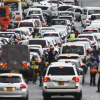Nairobi To Roll Out AI Traffic System to Curb City Congestion

Nairobi is introducing an Artificial Intelligence-driven traffic management system aimed at reducing congestion and improving the flow of vehicles across the city’s busiest roads.
According to the Kenya Urban Roads Authority (Kura), traffic jams cost the country nearly $1 billion (Sh129 billion) each year-around Sh353 million every day. The losses stem from wasted fuel, delayed deliveries, and reduced productivity. For many residents, long and unpredictable commutes have become part of daily life.
“I leave home before 6am and still get stuck for nearly two hours,” says Frank Soreh, who travels from Kasarani to the city centre.
Past efforts to ease congestion through road expansion have had limited success, often leading to more cars on the road rather than smoother travel. City planners now say the solution lies in smarter technology rather than more tarmac.
The city’s new Intelligent Transport Systems (ITS) will use sensors, cameras, and AI software to manage traffic signals and monitor road conditions in real time. The system replaces manual, officer-controlled junctions with a centralised, data-driven network capable of adjusting signal timings automatically.
“Traditionally, we collected traffic data manually and adjusted signals by hand,” a Kura official says. “Now, every change can be made remotely and instantly.”
Smart cameras will detect vehicle flow, record offences such as speeding or running red lights, and automatically forward the data for enforcement. The same technology will help identify emergencies by detecting sudden changes in traffic movement caused by accidents or obstructions.
The main control centre is being established at City Cabanas, where live feeds from over 200 intersections will be monitored continuously. Engineers and data analysts will oversee the network to ensure coordinated movement across major routes.
Building the Smart Network
The ITS rollout is being implemented in three stages. The first phase, which began earlier this year, covers 25 key intersections and includes redesigning junctions and installing sensors. The second phase will add 60 more junctions, linking roads such as Ngong Road, Jogoo Road, and Waiyaki Way into a unified network. The final phase will connect 210 intersections under one integrated digital system-the largest of its kind in East Africa.
The project involves coordination between Kura, the Kenya National Highways Authority (Kenha), and the Nairobi County Government to ensure both county roads and national highways operate under the same system. Acting county secretary Godfrey Akumali says, “All traffic lights will speak to each other through a central system. One manual junction can disrupt the flow of an entire corridor.”
AI-controlled traffic lights have already been tested on Ngong Road and in Kileleshwa, where signal timings adjust automatically based on the number of vehicles detected. However, older analogue systems still limit full integration across the network.
The technological upgrade is part of a broader plan to modernise Nairobi’s public transport system and reduce carbon emissions. Authorities are expanding the Bus Rapid Transit (BRT) network, which will have dedicated lanes, CCTV-equipped buses, and real-time tracking. The system is designed to carry far more passengers per hour than private vehicles, cutting both travel times and emissions.
Alongside this, Nairobi is promoting e-mobility solutions through partnerships with private companies such as Spiro, which is rolling out electric motorbikes and buses.
“We are partnering with the private sector to build charging hubs along key routes,” says Effie Konaka of Spiro. The company’s fleet has already covered more than 500 million kilometres of zero-emission travel across Africa, contributing voluntary carbon credits in Kenya.
Officials project that once the ITS network is fully operational, Nairobi could reduce travel times by up to 40 per cent, along with significant cuts in fuel use and vehicle emissions. However, experts caution that technology alone will not resolve all transport challenges.
“Nairobi is on a steep urbanisation curve,” a Kura engineer notes. “We must combine smart systems with efficient public transport and sustainable urban planning.”
The government plans to extend the ITS model to Mombasa and other major towns.





Add new comment